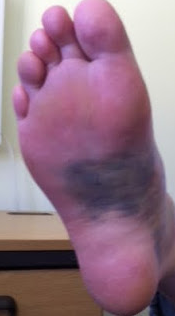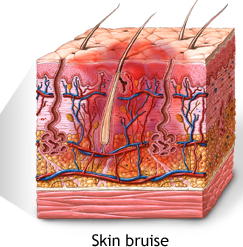Different stages of bruising are notable for different colorations. This article will not only break down these color changes but also explain the science behind them.
Different Stages of Bruise Healing

To understand the color changes associated with different stages of bruising (next section), it is first of all critical to understand how bruise form in the first place and what is involved in their gradual healing process.
RECOMMENDED FOR YOU:
Bruises form when a physical trauma or injury (that doesn’t involve a cut on the skin) causes damage to the small blood vessels beneath the surface of the skin causing them to leak blood into the surrounding soft tissues.
The blood collected in the soft tissues beneath the skin shows up as the discolored patches that are associated with bruising. Sometimes the pooled blood move down under the effect of gravity making the bruise to spread downwards accordingly during the different stages of bruising and healing.
Eventually the body reabsorbs the leaked blood gradually until the bruise goes away at some stage of bruising. Reabsorption involves the metabolism of the different components of the blood. As the contents of the blood collected under the skin changes with the metabolism of different components, the color of the bruises change accordingly until the bruise finally disappears.
Stages of Bruising Colors
A bruise goes through a sequence of color changes from the time it is formed to the time it finally heals. Understanding and observing the color of a bruise can help identify how old a bruise is and how close it is to full healing. Let us now break down the various stages of bruising colors so to speak:
Red
At their onset, bruised look red or pink in color because of the presence of iron-rich hemoglobin in the pooled blood. The area around the bruise may also get tender and swollen.
Dark blue or purple
Within one to two days from the time of injury or trauma, the bruise will then turn its color to dark blue or purple. This will continue through to the fifth day. It is attributed to low oxygen supply in the site of bruising as a result of swelling, which then causes the normally red hemoglobin to change its color accordingly.
Greenish
After day 5, the bruise then turns greenish as hemoglobin undergoes biochemical breakdown. The green coloration is usually an indication of high levels of biliverdin in the pooled blood and will continue to day 7.
Yellow or brown
After day 7, the bruise then turns pale yellow (usually as a result of presence of large amounts of bilirubin) or brown. This is the final stage of bruise healing and the bruise will not undergo any further color changes but instead fade away gradually until it is no more.
It however deserves a mention at this point that thesequence of color changes doesn’t happen such drastically but rather progressively, with varying shades of each color along the transition lines. For example, purple usually fades to violet as it comes close to changing to green and yellow begins with a dark shade which then turns to pale yellow and so on.
Most bruises will have cleared completely in 2 weeks’ time but some may stay along for as long as 4 weeks during the stages of bruising. Extent of the injury aside, some area of the body such as legs, thighs and arms also tend to stay bruised for longer than others.
The above sequence of color changes during the process of bruising may as well not occur in some cases due to some reasons such as formation of hematoma and, although rarely, presence of calcium deposits around the area of injury (heterotopic ossification)
A hematoma occurs when the body decides to wall off the blood leaked beneath the surface of the skin rather than “fix it” so to speak as explained previously. Where a hematoma is involved the bruise gets progressively bigger and more painful.
That is one of the reasons why you should seek medical attention if a bruise doesn’t respond to at home treatment measures such as icing, rest, and elevation among others. Get more information on how to heal a bruise here.
Stages of Bruising Pictures
That a picture is worth a thousand words is something no one would ever refute especially where such a visual topic as “stages of bruising colors” is concerned. In that regard we had to do our best to get you some nice pictures depicting the appearance of bruises through the different stages of healing and here are three of the best shots we could get (courtesy of the Medline Plus)

In the case of a deeply entrenched bruise, you might not be able to see the red color stage – which means that the first color you see is purple (or blue for that matter). This is because such bruises often take a bit longer to appear.
Stages of Bruising Chart
Clinicians and pathologist often rely on stages of bruising charts to evaluate domestic violence and child abuse. According to the Alabama Department of Forensic Services however, the presence of differing charts in different authoritative texts can give rise to errors and discrepancies or even lead to miscarriage of justice.
This argument was based on the conclusions of two studies: one by Langlois and Gresham involving 89 adults which entailed taking of photographs of bruises whose ages were known and another one by Stephenson and Bialas which involved 23 children who had sustained traumatic injuries.
The authors concluded that using color to estimate the age is not scientific and can in fact cause miscarriage of justice.
All in all, you may still want to use a bruising color chart to estimate how far your bruise is to healing. In that regard, here is such one chart:
Greenish coloration going forward in the stages of bruising indicate that the bruise has already started healing as they are the result of the different chemicals given off from the breakdown of hemoglobin.
 eTopical Precious Finds
eTopical Precious Finds


